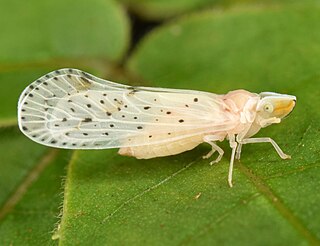
The Tettigarctidae, known as the hairy cicadas, are a small relict family of primitive cicadas. Along with more than 20 extinct genera, Tettigarctidae contains a single extant genus, Tettigarcta, with two extant species, one from southern Australia and one from the island of Tasmania. Numerous fossil species have been described from the Late Triassic onwards. Tettigarcta are the closest living relatives of the true cicadas.

A planthopper is any insect in the infraorder Fulgoromorpha, in the suborder Auchenorrhyncha, a group exceeding 12,500 described species worldwide. The name comes from their remarkable resemblance to leaves and other plants of their environment and that they often "hop" for quick transportation in a similar way to that of grasshoppers. However, planthoppers generally walk very slowly. Distributed worldwide, all members of this group are plant-feeders, though few are considered pests. The infraorder contains 2 superfamily, Fulgoroidea and Delphacoidea. Fulgoroids are most reliably distinguished from the other Auchenorrhyncha by two features; the bifurcate (Y-shaped) anal vein in the forewing, and the thickened, three-segmented antennae, with a generally round or egg-shaped second segment (pedicel) that bears a fine filamentous arista.

The Cixiidae are a family of fulgoroid insects, one of many families commonly known as planthoppers, distributed worldwide and comprising more than 2,000 species from over 150 genera.

Eurybrachidae is a small family of planthoppers with species occurring in parts of Asia, Australia and Africa. They are remarkable for the sophistication of their automimicry.

The family Derbidae is a large and diverse group of planthoppers, widely distributed in the tropics and also found in subtropical and temperate regions. It includes more than 150 genera and more than 1500 species. The adults suck the sap of plants while the nymphs live mainly in decaying organic matter, for example under the bark of dead tree trunks, feeding on fungi. In some groups of species the general structure of the insects is largely uniform, whereas in others like in the subfamily Otiocerinae various forms can be found. For example, the shape of the head, the antennae or the wings can differ considerably among genera and species.
Tainosia is an extinct monotypic genus of planthopper in the Nogodinidae subfamily Nogodininae and at present, it contains the single species Tainosia quisqueyae. The genus is solely known from the early Miocene, Burdigalian stage, Dominican amber deposits on the island of Hispaniola.

Issidae is a family of planthoppers described by Spinola in 1839, belonging to the order Hemiptera, suborder Auchenorrhyncha superfamily Fulgoroidea.

Nogodinidae is a family of planthoppers. They have membranous wings with delicate venation and can be confused with members of other Fulgoroid families such as the Issidae and Tropiduchidae. Some authors treat it as a subfamily of the Issidae.

Cixiinae is a planthopper subfamily in the family Cixiidae. It is one of three such subfamilies, the other two being the Bothriocerinae and the Borystheninae. While a few species had been tested in a larger study of the Fulgoroidea, neither the Cixiinae nor its tribes were analysed cladistically until 2002. Resolution of tribal relationships is incomplete and additional testing of the tribes with samples larger than one per tribe is needed.

Ricania speculum, common name Black planthopper or Ricaniid Planthopper, is a species of planthoppers belonging to the family Ricaniidae.

Achilidae is a family of planthoppers, sometimes called "achilids" in the order Hemiptera. There are at least 520 described species in Achilidae.

Otiocerinae is a subfamily of planthoppers in the family Derbidae with more than 100 genera and more than 1000 species. The species are widely distributed, especially in the Americas, Sub-Saharan Africa, as well as parts of Asia, Australia and the Pacific. Like in other Derbidae, the adults suck the sap of plants while the nymphs live mainly in decaying organic matter, for example under the bark of dead tree trunks, feeding on fungi.

Kakuna is a genus of planthopper in the family Delphacidae. It is found in China and Japan. The genus was circumscribed in 1935 by Shōnen Matsumura.

Asiracinae is a subfamily of delphacid planthoppers in the family Delphacidae. There are at least 30 genera and 180 described species in Asiracinae, which probably has a world-wide distribution.

Elicinae is a subfamily of tropiduchid planthoppers in the family Tropiduchidae, with Elica the type genus.

Dictyopharinae is a subfamily of dictyopharid planthoppers in the family Dictyopharidae. There more than 100 genera and 500 described species in Dictyopharinae.

Mimarachnidae is an extinct family of planthoppers known from the Cretaceous period. Their name is derived from spots on the wings of the first described genera, Mimarachne and Saltissus, being suggestive of spider mimicry, but these characters are not distinctive for the family as a whole. The family is characterised by "simplified venation and setigerous metatibial pecten and hind leg armature". as well as "rounded anterior margin of pronotum, double carination of pronotum and mesonotum"
Perforissidae is an extinct family of planthoppers. They are considered to belong to the group of "Cixiidae-like" planthoppers. Species are known from the Early to Late Cretaceous of Eurasia, North America and South America. The family was named by Shcherbakov in 2007
Fulgoridiidae are an extinct family of Mesozoic planthoppers. They are the earliest group of planthoppers known, and appear to be a paraphyletic assemblage ancestral to living planthoppers. The majority of known members of the family lived in the Jurassic period, though the group also includes one Cretaceous taxon. All currently known species are from Eurasia.
Qiyangiricaniidae is an extinct insect family of planthoppers. It was first named by Jacek Szwedo, Bo Wang, and Haichun Zhang in 2011 and contains only one genus, Qiyangiricania.














